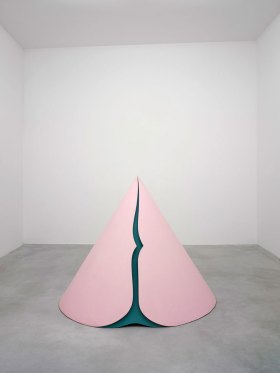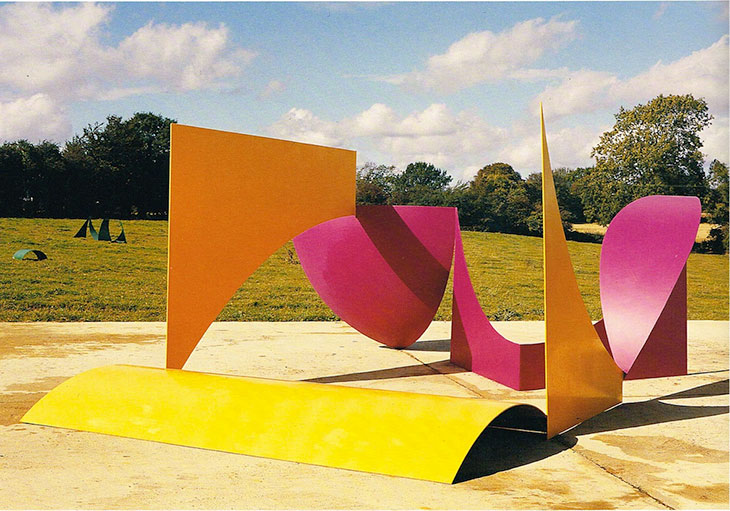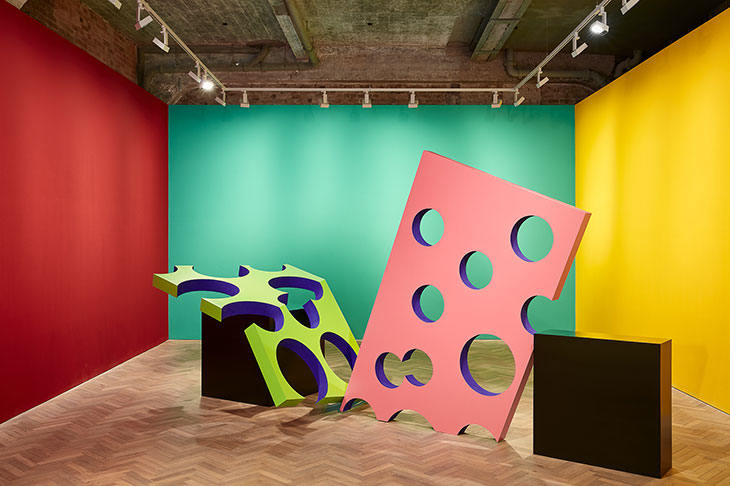In an interview to mark his 80th birthday in 2014, Phillip King explained the continuing lure of sculpture: ‘[It] might ostensibly be the most visible of arts in that the viewer can quickly gauge size, weight, colour and so on, but there is also something that escapes you in the most mysterious manner […] Exploring that sense of mystery is one of the things that has kept me making things for all these years.’
By that point, King had been making things for some six decades. He was one of the ‘New Generation’ of sculptors whose work of the 1960s thrust sculpture into modern life. King removed the plinth and painted materials such as fibreglass – and in doing so, asked new questions about the role of sculpture and what it could achieve. Alongside the efforts of his contemporaries, his curiosity and ambition transformed forever the way sculpture is made and how we look at it.

Rosebud (1962/65), Phillip King. Courtesy the artist and Thomas Dane Gallery; © Phillip King
King was the focus of retrospectives at the Whitechapel Art Gallery, Hayward Gallery, Yorkshire Sculpture Park and Forte de Belvedere, Florence, among others. But he was also an influential and popular teacher. I met him only once, alongside the sculptor Richard Long, a life-long friend and former student of King, and over that dinner got a firm sense of what a charismatic mentor King had been – committed to, and encouraging, fresh thinking. Remembering King now, Long writes: ‘Phillip King was a great human being. And in my opinion, he was the best artist of the New Generation of English sculptors in the sixties, with his beautiful and radical works, like Genghis Khan, a world-class sculpture. I first knew him when he was on the staff at Saint Martin’s: he was easily the best artist to talk to, open-minded, always with something thought-provoking to say.’
The sculptor William Tucker, who first met King in around 1960 at Saint Martin’s, when King was working for Henry Moore and teaching one evening a week in the sculpture department, shares Long’s sense of King as a radical thinker. ‘He had the most original mind of anyone I have ever met’ Tucker writes. ‘He also – and in consequence – made some of the most original sculpture of the 20th century’. Later generations of sculptors have felt King’s generous influence, too. ‘I remember meeting him in 2007 in his incredible studio in London,’ says Rana Begum. ‘He had a big smile on his face while he was working on a small sculpture […] I was so surprised to be so engulfed by colour and form as you walked into his studio […] I had never experienced anything like that before with such intensity.’
In 1999 King was elected President of the Royal Academy. He later spoke about the pressures of the role, and its impact on his productivity, but as he said in an interview in 2014: ‘I always felt as an artist it was too easy to stay in your ivory tower, and I fought against that, not least by teaching, but also by taking on public roles’ (he had also been a trustee of the Tate Gallery in the late ’60s). Recalling the launch of RA Editions, the academy’s archivist Mark Pomeroy describes how ‘Phillip threw himself into the project with enthusiasm’: ‘He decided to come into the print workshops [at the RA Schools] and make works on site. I remember the print tutor telling me how incredible it was working with him, with his questing mind and vigorous application to a medium he had never previously attempted.’

Dunstable Reel (1970), Phillip King. Courtesy Thomas Dane Gallery; © Phillip King
In 2018, at the age of 84, King took up residency alongside Alexandre da Cunha at Dora House (home to the Royal Society of Sculptors). Caroline Worthington, director of the RSS, reflects on King’s ‘enduring fascination with materials’, remembering how: ‘He arrived with bags and bags of stuff: from tiny tin buckets to semi-circular pieces of foam, pieces of metal and rope, coloured pigment and orange table tennis balls. From seeming chaos, an exciting show emerged over the week of the residency.’ When the exhibition was ready to open, ‘Phillip produced a ping-pong ball that he proceeded to roll through the top of one of his sculptures. Soon a series of ping-pong ball races were underway accompanied by gales of laughter.’ King’s sense of humour is caught by Richard Long, too, who remembers his ‘original’ driving: ‘He took bizarre routes, often with strange objects falling out of, or from the top of, his car.’

Colour on Fire (2017), Phillip King. Photo: Luke A. Walker. Courtesy Thomas Dane Gallery; © Phillip King
For the last 8 years of his life King was represented by the gallerist Thomas Dane. Up to this year, at the age of 87, he was still going to the studio nearly every day and showing those around him the simple pleasure of looking. Says Dane: ‘He taught us a lot, rejuvenated us and reminded us of the joy of looking at shapes and colours’. Tom Dingle, senior director at Thomas Dane Gallery, had a close relationship with King. ‘The thing that always struck me most about Phillip were his hands,’ he says. ‘They were tough and scarred from decades of cutting and carving all manner of materials.’ He continues: ‘He made virtually everything himself, thinking through materials with his hands as he worked on them. They were his most important tool and seemed to tell the story of his entire career.’
Jo Baring is director of the Ingram Collection and, with Sarah Turner, hosts the Sculpting Lives podcast.

‘He transformed how sculpture is made’ – a tribute to Phillip King (1934–2021)
Courtesy Thomas Dane Gallery; © Phillip King
Share
In an interview to mark his 80th birthday in 2014, Phillip King explained the continuing lure of sculpture: ‘[It] might ostensibly be the most visible of arts in that the viewer can quickly gauge size, weight, colour and so on, but there is also something that escapes you in the most mysterious manner […] Exploring that sense of mystery is one of the things that has kept me making things for all these years.’
By that point, King had been making things for some six decades. He was one of the ‘New Generation’ of sculptors whose work of the 1960s thrust sculpture into modern life. King removed the plinth and painted materials such as fibreglass – and in doing so, asked new questions about the role of sculpture and what it could achieve. Alongside the efforts of his contemporaries, his curiosity and ambition transformed forever the way sculpture is made and how we look at it.
Rosebud (1962/65), Phillip King. Courtesy the artist and Thomas Dane Gallery; © Phillip King
King was the focus of retrospectives at the Whitechapel Art Gallery, Hayward Gallery, Yorkshire Sculpture Park and Forte de Belvedere, Florence, among others. But he was also an influential and popular teacher. I met him only once, alongside the sculptor Richard Long, a life-long friend and former student of King, and over that dinner got a firm sense of what a charismatic mentor King had been – committed to, and encouraging, fresh thinking. Remembering King now, Long writes: ‘Phillip King was a great human being. And in my opinion, he was the best artist of the New Generation of English sculptors in the sixties, with his beautiful and radical works, like Genghis Khan, a world-class sculpture. I first knew him when he was on the staff at Saint Martin’s: he was easily the best artist to talk to, open-minded, always with something thought-provoking to say.’
The sculptor William Tucker, who first met King in around 1960 at Saint Martin’s, when King was working for Henry Moore and teaching one evening a week in the sculpture department, shares Long’s sense of King as a radical thinker. ‘He had the most original mind of anyone I have ever met’ Tucker writes. ‘He also – and in consequence – made some of the most original sculpture of the 20th century’. Later generations of sculptors have felt King’s generous influence, too. ‘I remember meeting him in 2007 in his incredible studio in London,’ says Rana Begum. ‘He had a big smile on his face while he was working on a small sculpture […] I was so surprised to be so engulfed by colour and form as you walked into his studio […] I had never experienced anything like that before with such intensity.’
In 1999 King was elected President of the Royal Academy. He later spoke about the pressures of the role, and its impact on his productivity, but as he said in an interview in 2014: ‘I always felt as an artist it was too easy to stay in your ivory tower, and I fought against that, not least by teaching, but also by taking on public roles’ (he had also been a trustee of the Tate Gallery in the late ’60s). Recalling the launch of RA Editions, the academy’s archivist Mark Pomeroy describes how ‘Phillip threw himself into the project with enthusiasm’: ‘He decided to come into the print workshops [at the RA Schools] and make works on site. I remember the print tutor telling me how incredible it was working with him, with his questing mind and vigorous application to a medium he had never previously attempted.’
Dunstable Reel (1970), Phillip King. Courtesy Thomas Dane Gallery; © Phillip King
In 2018, at the age of 84, King took up residency alongside Alexandre da Cunha at Dora House (home to the Royal Society of Sculptors). Caroline Worthington, director of the RSS, reflects on King’s ‘enduring fascination with materials’, remembering how: ‘He arrived with bags and bags of stuff: from tiny tin buckets to semi-circular pieces of foam, pieces of metal and rope, coloured pigment and orange table tennis balls. From seeming chaos, an exciting show emerged over the week of the residency.’ When the exhibition was ready to open, ‘Phillip produced a ping-pong ball that he proceeded to roll through the top of one of his sculptures. Soon a series of ping-pong ball races were underway accompanied by gales of laughter.’ King’s sense of humour is caught by Richard Long, too, who remembers his ‘original’ driving: ‘He took bizarre routes, often with strange objects falling out of, or from the top of, his car.’
Colour on Fire (2017), Phillip King. Photo: Luke A. Walker. Courtesy Thomas Dane Gallery; © Phillip King
For the last 8 years of his life King was represented by the gallerist Thomas Dane. Up to this year, at the age of 87, he was still going to the studio nearly every day and showing those around him the simple pleasure of looking. Says Dane: ‘He taught us a lot, rejuvenated us and reminded us of the joy of looking at shapes and colours’. Tom Dingle, senior director at Thomas Dane Gallery, had a close relationship with King. ‘The thing that always struck me most about Phillip were his hands,’ he says. ‘They were tough and scarred from decades of cutting and carving all manner of materials.’ He continues: ‘He made virtually everything himself, thinking through materials with his hands as he worked on them. They were his most important tool and seemed to tell the story of his entire career.’
Jo Baring is director of the Ingram Collection and, with Sarah Turner, hosts the Sculpting Lives podcast.
Unlimited access from just $16 every 3 months
Subscribe to get unlimited and exclusive access to the top art stories, interviews and exhibition reviews.
Share
Recommended for you
Antony Gormley has always believed that sculpture can change the world – and that faith is firmer than ever
An interview with Antony Gormley – public servant, Romantic artist and utopian thinker
‘Wood suits me, I’m a Saxon!’ – an interview with David Nash
The British sculptor has spent decades producing work from his sylvan surroundings. He discusses how it all began
In the studio with… Rana Begum
The artist recently moved into a new studio overlooking a cemetery in Hackney – the view’s great, but there is a minor mosquito problem